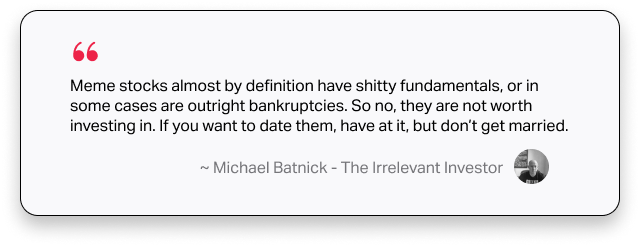

Wearing the Shorts: A Guide to Investing in Meme Stocks
Some say investing is no laughing matter, but meme stock investors are cackling all the way to the bank.
ByGuy Ovadia
Updated Jul 1, 2022
Many companies on MoneyMade advertise with us. Opinions are our own, but compensation and in-depth research determine where and how companies may appear.
Stock Trading
Active Investing
Everyone likes an underdog story, and that's exactly why the market for meme stocks has performed so well. It may sound funny, but meme stocks are no joke. Some who've invested in them have cashed out big all while sticking their middle finger at institutional short sellers. But how can the average investor beat capitalists at their own game? To answer that we first got to get into what a meme stock is and how investing in meme stocks could make you some money.
What are meme stocks?
What are meme stocks?
There's no shame in selling if you're satisfied with how your meme stock performed.
Meme stocks are shares in public companies that suddenly gain strong support from retail investors despite their poor fundamentals. These companies are usually in a poor financial condition which leads institutions to bet against them by shorting their stock.
Investments in meme stocks tend to be done to spite institutional investors by causing a short squeeze—inducing short sellers to abandon their positions to limit their financial loss.
How to find meme stocks
How to find meme stocks
The meme stock phenomenon revealed how a large number of small investors can coordinate with each other to manipulate the marketplace. As platforms like Robinhood made the stock market more accessible, Gamestop stock—the first successful meme stock—followed by AMC Entertainment Holdings, Inc. and Hertz, all saw outsized support from retail traders rallying together to buy up shares. Peak meme stock mania had some major wins for mom-and-pop investors and huge losses for institutional short sellers, so traders are pushing the same formula with other meme stocks like Revlon and Bed Bath & Beyond.
Robinhood
4.3
•
Stocks
Fundamentals
So, why are institutional investors shorting meme stocks in the first place? That's because these companies are suffering financially and are usually on the verge of bankruptcy if not already insolvent. When experienced hedge funds see poor balance sheets, disrupted business models, or any fundamental indicators of declining profits they will almost always short the company's stock. This strategy of relying on a company's fundamentals has historically been effective in the stock market, but social media is changing that.

Michael is the director of research at Ritholtz Wealth Management, cohost of the Animal Spirits podcast, and publisher of the Irrelevant Investor.
Sentiment
Once you've identified a publicly-traded company with bad financials and poor performance on the market, the next step is checking if it's a meme stock—or if it can become one. This is where social media becomes super important because most meme stocks gained momentum on forums like r/WallstreetBets on Reddit. The meme stock community on Reddit and Twitter holds discussion threads on popular meme stocks to buy and when to invest in them, so being on those social media platforms is crucial for getting clued in on the action.
Namesake
Another aspect that's important for determining if a stock could become a meme is its brand recognition. Potential meme stocks are almost always household companies with a recognizable name. A strong brand name helps to build a narrative around an otherwise failing company that can convince investors to become bullish and buy shares. The more synonymous the company's name is with its business, the more likely its stock will perform well.
Big bears
One thing that's crucial for meme stocks is that hedge funds are bearish on the company and act on that bearishness. In other words, big money must be betting against the meme stock. When institutions are pessimistic about a company, they short its stock to try profiting from its share price going down. When the stock is down but the company's on its last legs, the meme buyers jump in to buy shares. This usually occurs when the stock's price reaches the low single digits.
As retail clamors to buy up the meme stocks while they're cheap, they drive up the price at the expense of hedge funds short-selling it. That means institutional investors who were betting against the meme stock must now abandon their short positions and cut their losses. Sometimes a stock price rises even further as sellers give up on shorting the meme stock, thus relieving the downward price pressure. Meme stock holders rejoice when their share prices rally as institutional short sellers lick their wounds.
Endgame
Let's say you invested in some meme stocks on Tradestation and your portfolio is up like crazy. Now what? Well, one of two things could happen: the company recovers and lives to see another business day or it gets acquired. For an acquisition to occur, all the shares must be bought out at a premium and shareholders get paid the dollar value of all their shares plus a little extra. This is the best-case scenario for in-and-out meme stock traders who were looking forward to payday anyway.
TradeStation
Stocks
Things get a little trickier if the company you invested in gets miraculously resuscitated. If your shares aren't subject to a buyout, then you'll have to decide whether to keep holding or when to sell and realize your profits. It isn't guaranteed that the price of your investment will keep going up or will even hold up at the current price regardless of past performance, so there's no shame in selling if you're satisfied with how your meme stock performed. Another reason you may want to sell is to avoid getting stuck with shares in case of a trading halt like Robinhood once did with GME—though this is extremely rare and unusual.
How to invest in meme stocks
How to invest in meme stocks
Now that you know how meme stocks work, it's time for you to start hunting for them! The ideal window for investing in a meme stock is very short since you want to buy when prices are low but when there's still enough momentum for the share price to make a comeback. There is no meme stock ETF to make investing in them easier, so the best place to start investing in meme stocks is a trading platform that offers a large selection of stocks like Stash.
Stash
4.3
•
Stocks
You can use Stash to dollar cost average into your next meme stock investment and they'll even issue you a debit card that lets you spend your gains right away while earning rewards on some purchases. Other platforms with commission-free trading you can also try are Robinhood and Tradestation. Hurry, those Bed Bath & Beyond shares aren't gonna buy themselves!